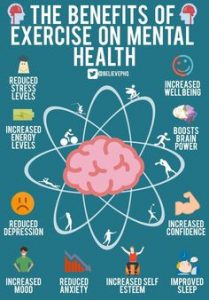The importance of regular exercise for our physical health is drilled into us starting in elementary school gym class. However, there are also mental health benefits that result from exercise. In multiple studies it has been found that exercise has been shown to reduce anxiety levels.
How does this work?
When one experiences a psychological stressor, the pathway in the brain that responds  to this is the NDMAR-ERK-MAPK pathway. This process involves multiple steps of phosphorylation and acetylation, eventually resulting in the opening of the chromatin and the alteration of gene transcription. When this pathway is over-activated, it leads to the formation of strong, long-term memories which are often times associated with anxiety and post-traumatic stress disorder (PTSD).
to this is the NDMAR-ERK-MAPK pathway. This process involves multiple steps of phosphorylation and acetylation, eventually resulting in the opening of the chromatin and the alteration of gene transcription. When this pathway is over-activated, it leads to the formation of strong, long-term memories which are often times associated with anxiety and post-traumatic stress disorder (PTSD).
It is thought that the decreased anxiety levels seen from exercise is due to changes in the GABAergic system. GABA is an inhibitory neurotransmitter; therefore, the increased gene transcription of a GABA synthesizing enzyme allows for more GABA to be created and excreted. With increased levels of this inhibitory neurotransmitter, it is less likely that this anxiety-related pathway will be over-activated leading to decreased levels of anxiety and better response to stress.
These conclusions were determined through experiments with mice and rats, but there was a similar experiment conducted with humans at UC Davis. Participants who exercised showed higher levels of GABA but they were not put through a stress tests like the experiments with mice and rats were. The similar increase in GABA indicates the similar conclusions of the two studies.
Maintaining a Balance
It is crucial that this GABAergic system maintains the correct balance of GABA. As previously discussed, not enough GABA can lead to anxiety and PTSD-related symptoms, because there is not enough inhibitory signaling going on in the brain. On the contrary, too much GABA can be dangerous as well. This excess of inhibitory signals can promote carelessness and cause an individual not to be as aware of danger.
Current Treatments
Medications– used to treat symptoms of anxiety and PTSD but do not target the cause. These are the most commonly used classes of medications.
- SSRIs (Serotonin Reuptake Inhibitors) which are also antidepressants: Fluoxetine, sertraline and paroxetine all work to decrease anxiety, depression and the panic associated with PTSD
- Atypical antipsychotics– risperidone, olanzapine and quetiapine are mostly used to treat PTSD to help with agitation and paranoia
- Mood stabilizers – sleeping tablets or anti-anxiety medications
Psychotherapy- also referred to as ‘talk therapy’ is very effective for treating PTSD. The patient meets once a week with the therapist for 3-6 months. These therapies include teaching the patient how to reframe their thoughts surrounding the traumatic event and learning how to be in control of one’s feelings
Usually a combination of medication and psychotherapy is used in the treatment of PTSD. However, with the recent research regarding the benefit exercise can have on mental health, that may become part of the treatment plans for this disorder. It would be a more natural way of using the body’s natural functions to try heal the pathways that have been impaired in the brain.